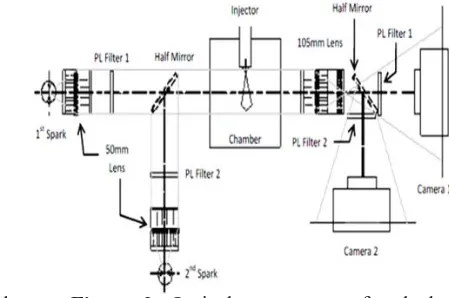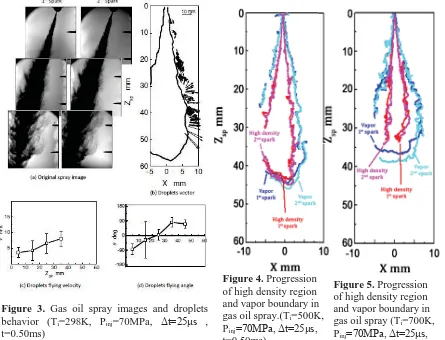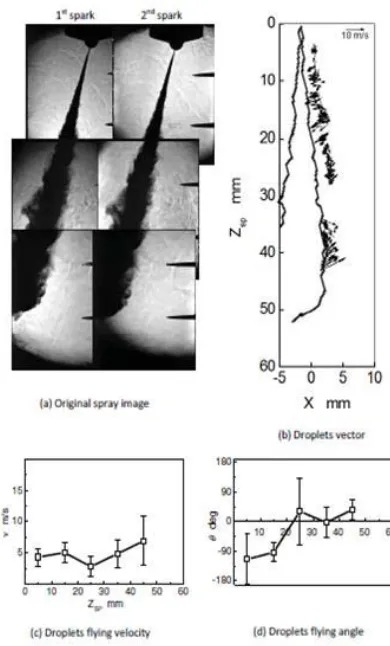PAPER • OPEN ACCESS
Comparision on dynamic behavior of diesel spray
and rapeseed oil spray in diesel engine
To cite this article: Azwan Sapit et al 2017 J. Phys.: Conf. Ser. 822 012058
View the article online for updates and enhancements.
Related content
Review of the investigation of mixture formation and combustion process using rapid compression machine and direct visualization system
M Jaat, Amir Khalid, B Manshoor et al.
-The effect of nozzle diameter, injection pressure and ambient temperature on spray characteristics in diesel engine
Adiba Rhaodah Andsaler, Amir Khalid, Nor Sharifhatul Adila Abdullah et al.
-Setting up a PDPA system for measurements in a Diesel spray
L Araneo, V Soare, R Payri et al.
Comparision on dynamic behavior of diesel spray and rapeseed
oil spray in diesel engine
Azwan Sapit1, a, Mohd Azahari Razali1, Mohd Faisal Hushim1, Norrizam Jaat1,
Akmal Nizam Mohammad1, Amir Khalid1, b
1Centre for Energy and Industrial Environment Studies (CEIES),Universiti Tun Hussein Onn Malaysia,Parit Raja, Batu Pahat, 86400 Johor, Malaysia.
Corresponding authors: azwans@uthm.edu.mya, amirk@uthm.edu.myb
Abstract. Fuel-air mixing is important process in diesel combustion. It significantly affects the combustion and emission of diesel engine. Biomass fuel has high viscosity and high distillation temperature and may negatively affect the fuel-air mixing process. Thus, study on the spray development and atomization of this type of fuel is important. This study investigates the atomization characteristics and droplet dynamic behaviors of diesel engine spray fuelled by rapeseed oil (RO) and comparison to diesel fuel (GO). Optical observation of RO spray was carried out using shadowgraph photography technique. Single nano-spark photography technique was used to study the characteristics of the spray while dual nano-spark shadowgraph technique was used to study the spray droplet behavior. Using in-house image processing algorithm, the images were processed and the boundary condition of each spray was also studied. The results show that RO has very poor atomization due to the high viscosity nature of the fuel when compared to GO. This is in agreement with the results from spray droplet dynamic behavior studies that shows due to the high viscosity, the RO spray droplets are large in size and travel downward, with very little influence of entrainment effect due to its large kinematic energy.
Keywords: Diesel spray, Atomization, Biomass fuel, Rapeseed oil
1. Introduction
Fuel that derived from biomass such as a vegetable oil fuel is a viable alternative to current fossil fuel and can be use readily to current day diesel engine [1-2]. However studies show that, when diesel engines use neat biomass fuel, NOx emissions increase [3]. Particulate emissions decreases at heavy load due to oxygenated nature of biomass fuel; in contrast, SOF (Soluble organic fraction) emissions increases at light load operation [4]. These kinds of emission formation are greatly affected by spray atomization. Precise optimization of the fuel injection, spray atomization and fuel-air mixing are among the fundamental factors that control the combustion and emission formation [5-6]. Application of high-pressure injection and high ambient temperature could promote better spray atomization and fuel-air mixing, and this should be applicable to biomass fuel too. There are also studies which suggest the geometry of piston cavity design can improve mixture formation and emission level. Generally, biomass fuel is subjected to transesterification process to improve biomass fuel combustion and prevent carbon buildup during engine combustion [7]. However, it is still desirable to use neat biomass fuel without transesterification, especially when the technology to process biomass fuel to biodiesel is not accessible (rural area) and when considering cost. Thus, it is important to firstly understand the spray characteristics of biomass fuel, which is the objective of this study by the means of optical technique. In addition, by using the same technique fitted with dual nano-spark shadowgraph optical arrangement, rapeseed oil spray droplet behavior can be studied.
2. Design of Experiment
light [8] to a still camera. The spray chamber was filled with inert gas mixture of nitrogen and argon to prevent spray ignition. When ambient temperature reaches designated temperature after termination of rapid compression, fuel was injected into the spray chamber and spray behavior was taken by the optical system. Figure 2 shows the dual nano-spark optical arrangement [8] which can take simultaneously two pictures with little time interval of the same spray. All the images taken by films were scanned and changed to digital pictures. Then using in house algorithm system developed by Yatsufusa[8], the image is analyze and spray fuel droplet can be verified.
Fuels used were rapeseed oil (RO) and diesel fuel which is also known as gas oil (GO). The kinematic viscosity of RO is 47.78mm2/st@303K (density 911kg/m3) and GO 3.30 mm2/st@303K (827kg/m3). The 50% distillation temperatures of RO and GO are about 880K and 570K, respectively.
3. Result and discussion
[image:3.595.296.521.275.424.2]Figure 3 shows GO spray image and its analysis at Ti=298K, Pinj=70MPa, t=0.50ms aSOI (after start of injection), taken by dual nano-spark shadowgraphy and time interval between nano-spark 1 to 2 is Δt=25μs. Figure 3 (a) shows the original images, (b) shows the droplet vector calculated by comparing the image from camera 1 to camera 2, (c) shows the averaged droplet flying velocity and (d) shows the averaged droplet flying angle. Figure 3 (b) y axis shows the spray travel distance with Zsp=0 equal to nozzle tip. The analysis first divides spray length into 4 sections, 0-25% (upper), 25-50% (middle), 50-75% (lower) and 75-100% (tip) of spray length for notation purpose. In fig.3(c) and (d), for Zsp=0 to 60mm, each 10mm is divided into individual sections, with the averaged value is calculated for each section. The flying angle is considered to be 0° along the x axis, with positive value clock-wise. Error bar shows the standard deviation.
[image:3.595.76.286.276.422.2]Figure 1. Spray observation system and optical arrangement for single nano-spark shadowgraph photography method.
Figure 2. Optical arrangement for dual nano-spark shadowgraph photography technique
From the vector line shown in Figure.3(b), it can be seen that the droplets in the middle and lower section of the spray moving outward from the spray boundary, meanwhile the droplets in the upper section is moving inside toward the spray body. This can be confirmed by observing the droplet flying angle graph in Figure.3(d), as the section of Zsp=0~20mm shows negative value. Droplets of the upper section, which subjected to atomization for a longer duration, has smaller diameter and easier to be influence by air entrainment due to small kinetic energy compared to droplets of the medium and lower section. This made the upper section droplets seem to be sucked into, or entrained into the spray body. In comparison, the middle and lower section photography at Ti=500K, Pinj=70MPa and t=0.50ms (aSOI).
[image:4.595.76.521.151.491.2]The 4 lines shows high density liquid phase and vapor phase with the former dictated by red line and the later by blue line. Furthermore, the darker color represent analysis image from camera 1 (1st spark) and the lighter color for camera 2 (2nd spark). Y axis is the spray length and X axis is the spray cross section thickness. From the figure, it can be observethat the vapor phase become large at spray tip section. This characteristic cannot be seen in the upper and middle spray section. It is believed that compared to the upper section, larger spray droplets at the spray tip section with relatively high velocity that is continuously formed and then vaporized, made the vapor phase in this section become larger. Figure 5 shows the condition at Ti=700K, Pinj=70MPa and t=0.50ms (aSOI), similar to Figure 4 with different on the temperature. When compared to Ti=500K, it can be observed that the vapor phase on the spray droplets
Figure 3. Gas oil spray images and droplets behavior (Ti=298K, Pinj=70MPa, Δt=25μs , t=0.50ms)
Figure 4. Progression of high density region and vapor boundary in gas oil spray.(Ti=500K,
Pinj=70MPa, Δt=25μs,
t=0.50ms)
Figure 5. Progression of high density region and vapor boundary in gas oil spray (Ti=700K,
Pinj=70MPa, Δt=25μs,
formed after the formation of spray body thus having a bigger kinetic energy fly outward. Figure 4 shows image analysis of high density liquid phase and vapor phase taken by dual nano-spark photography at Ti=500K, Pinj=70MPa and t=0.50ms (aSOI). The 4 lines shows high density liquid phase and vapor phase with the former dictated by red line and the later by blue line. Furthermore, the darker color represent analysis image from camera 1 (1st spark) and the lighter color for camera 2 (2nd spark). Y axis is the spray length and X axis is the spray cross section thickness. From the figure, it can be observe that the vapor phase become large at spray tip section. This characteristic cannot be seen in the upper and middle spray section. It is believed that compared to the upper section, larger spray droplets at the spray tip section with relatively high velocity that is continuously formed and then vaporized, made the vapor phase in this section become larger.
[image:5.595.309.504.268.591.2]Figure 5 shows the condition at Ti=700K, Pinj=70MPa and t=0.50ms (aSOI), similar to Figure 4 with different on the temperature. When compared to Ti=500K, it can be observed that the vapor phase on the spray tip region become more large. In addition, the high density liquid phase that existed in the spray tip region at Ti=500K can be seen quickly vaporized, making the spray penetration shorter. Figure 6 shows RO spray image and its analysis at Ti=298K, Pinj=70MPa, t=0.50ms aSOI (after start of injection) taken by dual nano-spark shadowgraphy and time interval betweenthe color and have different sizes of sphere for red color. The prototype color detection assistive device, for experimental purposes only detects 4 base
Figure 6. Rapeseed oil spray images and droplets behavior (Ti=298K, Pinj=70MPa,
t=0.50ms, Δt=25μs)
Figure 7. Rapeseed oil spray images and droplets behavior (Ti=700K, Pinj=70MPa,
t=0.50ms, Δt=25μs)
[image:5.595.105.499.271.599.2]colours and HSV within its range. Besides the HSV range, the result will display unknown or not detected. nano-spark 1 to 2 is Δt=25μs, similar to Figure.3. It can be observed from Figure 6(b), droplets vector in the upper section especially at Zsp=0~20mm is small, similar to that of the GO. Air entrainment influence also can be seen as the droplets are moving toward the spray body. By observing the section of Zsp=0~20mm of Fig.4(c) and (d), which has similar value to GO, it is understood that the RO spray upper section droplets dynamic is similar to GO.
In contrast, at Zsp=20~40mm, the droplets move along the spray axis, with smaller entrainment effect. The same tendency can be observed when Zsp=40mm and larger. This flying angle tendency of RO spray droplets at middle and lower section is different from GO. Difference in droplet size, with the larger droplets of RO have bigger kinetic energy and the not easily affected by air entrainment. This made the droplets move along the spray axis with little deviation and believed to the one of the reason that made RO spray cone angle smaller when compared to GO. Fuel droplets on the spray tip is continuously under surrounding gas aerodynamic forces, decreasing its velocity, and at the same time, the droplets that came after that pushes forward and replace the existing droplets on the spray tip. The droplets with low kinetic energy are pushed aside and form the outer spray region. This mechanism can be seen on the GO and RO spray. RO spray has high viscosity which made the droplets (quantity) that were pushed aside due to aerodynamic forces was small in numbers. This in turn made the spray cone angle smaller than of the GO and also the branching structure was not well developed. The final result is poor atomization for RO spray. In contrast, as the RO spray droplets kinetic energy is greater than of the GO, the spray penetration length is longer.
Figure 7 shows RO spray image and its analysis at Ti=700K, Pinj=70MPa, t=0.50ms aSOI and time interval between nano-spark 1 to 2 is Δt=25μs, similar to Figure 6. The high ambient temperature decrease RO spray viscosity and this can be confirmed with the increase of spray cone angle. In addition when compared to Figure 5(b) at Ti=298K where air entrainment effect can be clearly seen especially at the middle and lower section, it can be observed that droplets fly inward to the spray body exhibiting the influence of air entrainment. Figure 7(c) and (d) shows that the droplets velocity vector becomes small and at the lower section can be seen to fly outward of spray body. Decrease in the droplets size due to lower viscosity of RO spray is believed to be the reasons of these results. Based on these findings, it is clear that high ambient temperature improves atomization of RO spray.
4. Conclusion
Rapeseed oil (RO) has very poor atomization when compared to gas oil (GO) spray. This is in agreement with the results from spray droplet dynamic behavior studies that show due to the high viscosity, RO has larger droplets size with bigger kinematic energy and not easily influence by the air entrainment, especially at the lower section of the spray. High ambient temperature promotes RO spray to expands further from the
center line and improve atomization. However, it should also be noted that even at Ti=700K, evaporation
of RO spray can little be seen, and vapor region almost cannot be detected. This characteristic poses a problem to engine with low ambient temperature and running at low load, as it can be the cause of SOF increase due to poor atomization of the RO fuel. Very high ambient temperature is needed to improve the
atomization of RO as shown in the result at Ti=850K. This also indicate that other methods beside of very
high ambient temperature; which difficult to attain when running at low speed, are needed to improve the atomization process is a must when using RO.
Acknowledgement
The authors also would like to thank the Ministry of Higher Education, Malaysia for supporting this research under Exploratory Research Grant Scheme (ERGS) vot.E033. The author would like to express his gratitude to Prof. Dr.Yoshiyuki Kidoguchi from Power Laboratory, The University of Tokushima, Japan
for his advice and guidance in this research.
References
[1] R. D. Misra and M. S. Murthy 2010 Straight vegetable oils usage in a compression ignition engine—A review Renewable and Sustainable Energy Reviews14 3005-3013
[image:7.595.94.292.143.376.2][2] Khalid, A. 2013 Effect of ambient temperature and oxygen concentration on iIgnition and combustion process of diesel spray Asian Journal of Scientific Research6(3) 434-444
[image:7.595.400.512.144.388.2]Figure 8. Vaporization of rapeseed oil spray (Ti=850K, Pinj=70MPa, t=0.50ms)
Figure 9. Boundary analysis of vaporization of rapeseed oil spray (Ti=850K, Pinj=70MPa, t=0.50ms)
[3] Nabi M. N., Shahadat M. M. Z., Rahman M. S. and Beg M. R. A. 2004 Behavior of diesel combustion and exhaust emission with neat diesel fuel and diesel- biodiesel blends. SAE Paper01
3034
[4] W. Jazair, T. Harada, S. Kubo and Y. Kidoguchi 2007 Improvement of emissions in a DI diesel engine fuelled by bio-diesel fuel and waste cooking oil SAE Paper01 2029
[5] A.Sapit et al 2013 Effect of wall configuration on atomization of rapeseed oil diesel spray impinging on the wall Applied Mechanics and Materials315 320-324
[6] Khalid, A., Hayashi, K., Kidoguchi, Y., and Yatsufusa, T 2011 Effect of air entrainment and oxygen concentration on endothermic and heat recovery process of diesel ignition SAE Technical Papers
01 1834
[7] Khalid, A., Tamaldin, N., Jaat, M., Ali, M.F.M., and Manshoor, B., Zaman, I 2013 Impacts of biodiesel storage duration on fuel properties and emissions Procedia Engineering68 225-230 [8] A. Sapit, S. Nagayasu, Y. Tsuboi, Y. Nada, and Y. Kidoguchi 2011 A study on improvement of
diesel spray characteristics fueled by rape-seed oil SAE Paper32 0561



